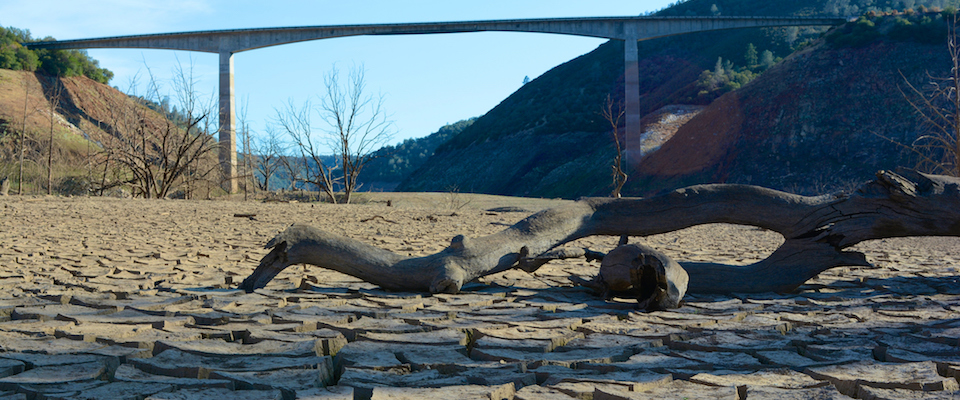You know a drought is serious when Lady Gaga tapes a public service announcement on water conservation. Actually, the pop star’s decision is more quid pro quo than largesse. In exchange for permission to film a music video at San Simeon’s Hearst Castle State Monument—which required temporarily refilling the emptied and leaky Neptune Pool—Gaga agreed to donate $250,000 to the castle foundation (in part to fix those leaks), fund a $25,000 water stabilization study, and star in the PSA.
California Gov. Jerry Brown wrote her a public thank you note, apparently figuring the state needs all the help it can get in this worst-in-500-years drought. We may muddle through this year, but if the dry spell persists, it’s Katy bar the door. Silicon Valley magnates will be forced to fill their swimming pools with Grey Goose vodka. Central Valley farmers will be taking jobs at Wal-Mart.
Well, maybe not. Perhaps Lady Gaga won’t be the only person to see, in California’s current crisis, an opportunity. Some experts are hoping we embrace the chance to wean ourselves off of the antiquated systems that have kept the water flowing to date, and are pushed into the technology and protocols of the 21st Century.
Indeed Berkeley Professor of Civil and Environmental Engineering David Sedlak says the drought might be the impetus needed to goad California to “Water 4.0”
He explains that Water 1.0 dates to the Roman Empire, when the first engineered aqueducts were constructed. Water 2.0 is characterized by the treatment and filtration of drinking water, while Water 3.0 gave us modern sewage plants and water conveyance systems. But Water 3.0 isn’t sufficient to sustain us in an era of rising population and expectations, aging water infrastructure, and diminishing freshwater resources.
For that we need Water 4.0, which will require a resilient, multi-faceted approach. This will involve conservation, water recycling (bottom line: someday you’ll be drinking purified sewage), development of local surface sources, recharging aquifers with storm water, amending landscaping standards, applying smart technology to irrigation systems, and marine desalinization.
“There’s some low-hanging fruit,” Sedlak says. “We can implement modest conservation measures immediately and achieve a 20 percent reduction in consumption. But we’re going to need some serious policy initiatives and citizen support to go beyond that.”
But go beyond that we must—nature is dealing the cards here. And for that matter, Water 4.0 is already being uploaded.
“Las Vegas, for example, paid people to take out their lawns, and they made dramatic cuts in consumption in a short period of time,” Sedlak says. “That initiative alone is saving them 10 million gallons a day.“
Southern California is also getting with the program.
“The water utilities in the south state started to see the light when a drought hit them in the 1990s, and they’ve been investing in Water 4.0 infrastructure,” he says. “They built new reservoirs, and they’ve greatly expanded recycling capacity. They’re purifying wastewater for consumption, and also using it to recharge aquifers. Virtually all of the flow of the Santa Ana River is reclaimed—and very clean—wastewater.”
High technology can also take some of the pain out of the transition. Big conservation gains can be obtained simply by eliminating “dumb” irrigation systems—for instance, rain bird sprinklers you turn on when you walk into the backyard with your morning cup of coffee and notice the sun is beating down on your head like a ball peen hammer on an anvil.
“We now have cheap sensors that can be integrated with wireless systems to make irrigation systems intelligent,” Sedlak says.“They measure soil moisture and ambient temperature to determine the best time to irrigate, and how much water to use. For most households, the greatest water usage occurs outdoors, so we could realize some really significant water savings if we changed our irrigation systems on a broad scale.”
Marine desalinization is another important tool for defanging drought. Sedlak observes that the technology is mature, and is used widely throughout the world to great success. That includes California. Three desalinization plants already have been built, and 15 more have been proposed. And construction of the largest desal plant in the western hemisphere is now underway in Carlsbad. When completed, it will pump out 50 million gallons of potable water daily.
“There can be issues with coastal impacts, energy consumption and carbon emissions, and those will have to be taken into account,” Sedlak said. “But desalinization is an important component of Water 4.0. It’s good insurance.”
That all sounds pretty rosy. So are we ready to kick the water export habit, the practice of shipping most of the North State’s water to the South State? Not so fast, cautions Sedlak.
“California isn’t ready to transit off imported water yet, and probably won’t be ready for the next few decades, particularly if we’re going to sustain (Central Valley) agriculture,” he says. “If we were just talking about cities, we might be able to satisfy most of their needs (with Water 4.0). But agriculture consumes most of the water in the state.”
About 80 percent, in fact. Sedlak declined to discuss retiring drainage-impaired croplands, or even reducing agricultural water deliveries; either could save millions of acre feet of water yearly. That’s another part of the water conversation—or more accurately, the Water Wars. But it doesn’t involve any low-hanging fruit.



















